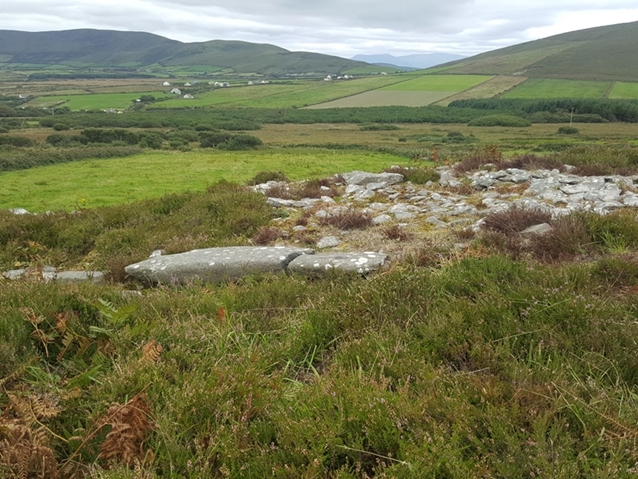Type: Ogham: Stone fort/cashel (possible souterrain)
Townland: Baile Uí BhaoithínTownland of the little hut[s]

Found:
According to Hitchcock (1856, 439-41; Macalister 1945, 165), it was found lying beside Cathair na gCatFort of the Cats and placed inside the fort by the discoverer 'for protection'. According to Curran (OPW file) it was discovered acting as the entrance lintel to the souterrain within the cashel. He was of the opinion that the ogham stone had been taken from the nearby ancient cemetery called An Raingiléis: Origins likely to be from the word Eaglais (church)
In 1887 Ferguson stated that the stone had been found in an adjoining killeen (Cuppage 1986, 194-5). Townland of Ballywiheen and barony of Corkaguiney. (GPS coordinates -10.407534, 52.156204)
Original:
Find location probably original site.
Last Recorded:
Re-erected on the knoll, at or near the original site National Monuments Service public map viewer on www.archaeology.ie.
'Smooth grey sandstone with a purple grain running through it', 1.92m x 0.46m x 0.16m (Moore , unpub MA thesis)
'The stone was smashed into 3 pieces in the 1880's (in search of gold) and one fragment was lost' (Cuppage 1986, 194) taking with it the last three letters (-TOS).
A small circular cashel with a raised interior, known as Cathair na gCat. Inside are the remains of two stone huts, a possible souterrain and an ogham stone. (Cuppage 1986, 194-5). It is worth noting, considering the number of ogham stones associated with church sites, that there is an early Christian settlement close by, known as Raingiléis.
TextApart from the loss of the last three letters, 'the inscription is otherwise perfect' (Macalister 1945, 165). Inspection of the inscription with Fionnbarr Moore at the time of scanning found that the initial T is faint but discernible. The M of MAQI is at the point of the break in the stone but the lower half of the M, towards the back of the stone, is clear. A spall has removed the upper half. SAGARRET is clear.
TranscriptionTOGITTACC MAQI SAG{A}RET[TOS].
Translation'of Toicthech son of Sáraid?'.
CommentaryIn this inscription we appear to have an example of an 'erroneous...addition of a single score' with SAGARETTOS for expected SAGRETTOS (Sáraid?) (McManus 1991, 7, 108). According to McManus (1991, 84) the name TOGITTACC was formed from the word for 'good luck' with an adjectival suffix -ākos. The spelling of TOGITTACC (for an expected TOGETTACC[I]) may reflect the falling together of unstressed /e/ and /i/ prior to syncope (McManus 1991, 82, 118). This inscription may be dated to the first half of the sixth century based on the preservation of -OS (though now lost) in SAGARETTOS and the loss of -I in TOGITTACC (McManus 1991, 94, 97)..
History of RecordingDiscovered by Rev. J. Goodman in 1855 (Macalister 1945, 165)..
ReferencesBennett I. and Uí Shíthigh B. (1995): Ogham Stones of the Dingle Peninsula. Ballyferriter, p. 9.
Cuppage, J. et al (1986): Archaeological Survey of the Dingle Peninsula. Ballyferriter, pp 194-5.
Macalister, R. A. S. (1898): 'Ballywiheen Church, Ballyneanig, Co. Kerry', JRSAI 28, pp 15-20.
Macalister, R.A.S. (1945): Corpus inscriptionum insularum Celticarum, pp 165-6.
McManus, D. (1991): A guide to ogam. Maynooth Monographs 4, pp 7, 66, 82, 84, 87, 89, 108, 118, 123.
Websites and Online Databases
Gippert, J. (2001): Thesaurus Indogermanischer Text-und Sprachmateriale. TITUS OGAMICA. (3rd edition) University of Frankfurt: titus.fkidg1.uni frankfurt.de/ogam/frame
CISP (Celtic Inscribed Stones Project): www.ucl.ac.uk/archaeology/cisp/database/
Kathleen Reen